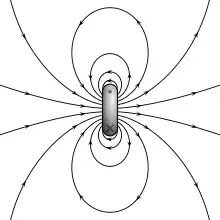I was reading up on De Sitter spaces, which states that the gravitational effects from a black hole is indistinguishable from any other spherically symmetric mass distribution. This makes a lot of sense to me.
I'm now super curious, can we just formulate all the properties of a black hole beyond the limit at which GR is needed in a completely Maxwellian / Newtonian sense? The Wikipedia article on the Kerr-Newman metric seems to indicate so, but the equations are in terms of the GR metrics. This is not what I want, I want a simplification, a limit-case of that math.
Ted Bunn answered a part of my question in Detection of the Electric Charge of a Black Hole. Let me repeat the stupidly simple form of the gravitational and electric field for a black hole beyond the point at which GR is needed.
$$\vec{g} = \frac{GM}{r^2} \hat{r}$$
$$\vec{E} = \frac{Q}{4\pi\epsilon_0 r^2} \hat{r}$$
Correct me if I'm wrong, but these would be a meaningful and accurate approximation in many, in fact, most situations where we would plausibly interact with a black hole (if we were close enough that these are no longer representative, we'd be risking a date with eternity).
Question: Fill in the blank; what would the magnetic field $\vec{B}$ around a black hole be?
Here is why I find it non-trivial: Every magnet in "our" world has some significant waist to it. So here is a normal magnet.

What happens when this is a black hole? Would the approximation for $\vec{B}$ that I'm asking for have all the magnetic field lines pass through the singularity? Or would they all pass through the event horizon radius but not necessarily a single point?
I think most people who have understood this already, but ideally the answer would use the 3 fundamental metrics of a black hole. Mass $M$, charge $Q$, and angular momentum $L$. The prior equations for gravity and electric field already fit this criteria. So the answer I'm looking for should be doable in the following form.
$$\vec{B} = f \left( M, Q, L, \vec{r} \right) $$